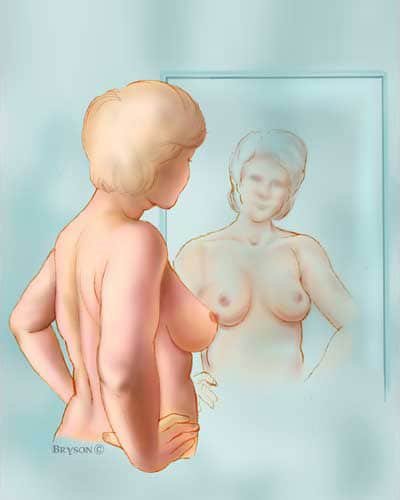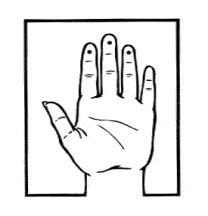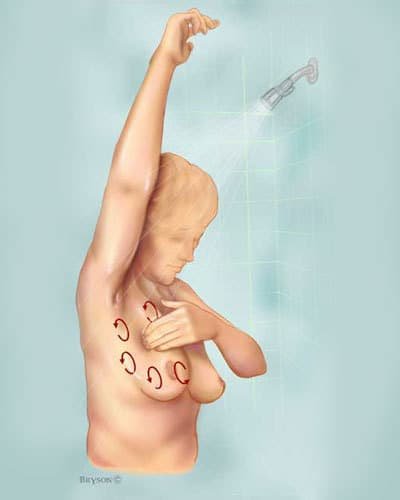Why check your breasts?
Breast cancer is the most common cancer in the UK. Both women and men can be affected by it, so it’s important to be breast aware. Being breast aware is part of caring for your body. It means getting to know how your breasts look and feel so you know what is normal for you. Remember, everyone’s breasts feel a little different and that is why it is important you get to know what your breasts are like. At first, when you are checking yourself, you may not be very confident about what you are feeling, but stick with it. After a while, you will come to know your breasts and in that way you can then feel more confident about noticing any unusual changes and reporting it to your GP.
We encourage early detection of breast cancer as the sooner breast cancer is diagnosed the more effective treatment may be.
The 4 breast rules
- Look at and feel your breasts so you know what’s normal for you.
- Do this regularly to check for changes.
- Tell your doctor as soon as possible if you notice anything.
- Attend for breast screening if aged 50 or over
The 5 steps of a breast self-examination
 Step 1: Begin by looking at your breasts in the mirror with your shoulders straight and your arms on your hips.
Step 1: Begin by looking at your breasts in the mirror with your shoulders straight and your arms on your hips.
Here’s what you should look for:
- Breasts that are their usual size, shape, and color
- Breasts that are evenly shaped without visible distortion or swelling
If you see any of the following changes, bring them to your doctor’s attention:
- Dimpling, puckering, or bulging of the skin
- A nipple that has changed position or an inverted nipple (pushed inward instead of sticking out)
- Redness, soreness, rash, or swelling
 Step 2: Now, raise your arms and look for the same changes.
Step 2: Now, raise your arms and look for the same changes.
Step 3: While you’re at the mirror, look for any signs of fluid coming out of one or both nipples
- This could be a watery, milky, or yellow fluid or blood. If anything like this – go and see your GP.
 Step 4: Next, feel your breasts while lying down
Step 4: Next, feel your breasts while lying down
 Using your right hand to feel your left breast and then your left hand to feel your right breast. Use a firm, smooth touch with the first few finger pads of your hand, keeping the fingers flat and together. Use a circular motion, about the size of a 50 pence piece.
Using your right hand to feel your left breast and then your left hand to feel your right breast. Use a firm, smooth touch with the first few finger pads of your hand, keeping the fingers flat and together. Use a circular motion, about the size of a 50 pence piece.- Cover the entire breast from top to bottom, side to side — from your collarbone to the top of your abdomen, and from your armpit to your cleavage.
- Follow a pattern to be sure that you cover the whole breast. You can begin at the nipple, moving in larger and larger circles until you reach the outer edge of the breast. You can also move your fingers up and down vertically, in rows, as if you were mowing a lawn. This up-and-down approach seems to work best for most women. Be sure to feel all the tissue from the front to the back of your breasts: for the skin and tissue just beneath, use light pressure; use medium pressure for tissue in the middle of your breasts; use firm pressure for the deep tissue in the back. When you’ve reached the deep tissue, you should be able to feel down to your ribcage.
 Step 5: Finally, feel your breasts while you are standing or sitting.
Step 5: Finally, feel your breasts while you are standing or sitting.
- Many women find that the easiest way to feel their breasts is when their skin is wet and slippery, so they like to do this step in the shower.
- Cover your entire breast, using the same hand movements described in step 4.
Video clips
In this video, the lady uses two fingers to examine her breasts. We would advocate using three. And remember, you are feeling with the tips of your fingers in a circular motion. In this video, they give advice on when is best to check your breasts – but if you find this difficult to maintain, then do a breast self-examination whenever you can, roughly once a month.
Some tips of doing a breast self-examination
- Try to get in the habit of doing a breast self-examination once a month to familiarise yourself with how your breasts normally look and feel. Examine yourself several days after your period ends, when your breasts are least likely to be swollen and tender. If you are no longer having periods, choose a day that’s easy to remember, such as the first or last day of the month. But if doing it a specific time every month will prove difficult for you – you can just do it once a month, any time of the month.
- Don’t panic if you think you feel a lump. Most women have some lumps or lumpy areas in their breasts all the time. Only 20% of women (1 in 5) who have a suspicious lump biopsied turn out to have breast cancer.
 Breasts tend to have different “neighborhoods.” The upper, outer area — near your armpit — tends to have the most prominent lumps and bumps. The lower half of your breast can feel like a sandy or pebbly beach. The area under the nipple can feel like a collection of large grains. Another part might feel like a lumpy bowl of oatmeal.What’s important is that you get to know the look and feel of YOUR breasts’ various neighborhoods. Does something stand out as different from the rest (like a rock on a sandy beach)? Has anything changed? Bring to the attention of your doctor any changes in your breasts that last over a full month’s cycle OR seem to get worse or more obvious over time.
Breasts tend to have different “neighborhoods.” The upper, outer area — near your armpit — tends to have the most prominent lumps and bumps. The lower half of your breast can feel like a sandy or pebbly beach. The area under the nipple can feel like a collection of large grains. Another part might feel like a lumpy bowl of oatmeal.What’s important is that you get to know the look and feel of YOUR breasts’ various neighborhoods. Does something stand out as different from the rest (like a rock on a sandy beach)? Has anything changed? Bring to the attention of your doctor any changes in your breasts that last over a full month’s cycle OR seem to get worse or more obvious over time.- You may want to start a journal where you record the findings of your breast self-exams. This can be like a small map of your breasts, with notes about where you feel lumps or irregularities. Especially in the beginning, this may help you remember, from month to month, what is “normal” for your breasts. It is not unusual for lumps to appear at certain times of the month, but then disappear, as your body changes with the menstrual cycle (if you are still menstruating). Only changes that last beyond one full cycle, or seem to get bigger or more prominent in some way, need your doctor’s attention.
[quote]Patients often think that mammography will pick up every breast cancer – THIS IS NOT TRUE. In fact, mammography misses at least 10 percent of breast cancer. And even if your yearly or 3 yearly mamography check up says you are clear, breast cancer can still happen BEFORE your next mammography is due. That’s why it is important to check your breasts monthly yourself. And if you feel a lump that doesn’t show up on a mammogram, bring it to your doctor’s attention. Get it evaluated.[/quote]
Want more information?
Click on one of the links below.
- I’ve found a breast lump (always get lumps checked out by a GP)
- How breasts develop and change throughout your life
- Breast changes to look and feel for
- Breast screening
- Helping someone with learning difficulties be breast aware.
Websites
